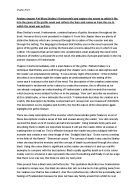Consider the ways in which Mary Shelley uses different Gothic settings to contribute to the gothic effects of the novel
Neema Daniel 13AXS
Consider the ways in which Mary Shelley uses different Gothic settings to contribute to the gothic effects of the novel
Settings are central in generating a mood or atmosphere and even symbolising literary themes. Through Shelley’s presentation of extreme settings like the Arctic and Mont Blanc, in Switzerland, the Gothic effect of isolation is introduced; even simple domestic scenes like the De Lacy’s home can reveal the Gothic notion of dichotomy between the normal and the abnormal. Yet arguably Shelley intertwines Romantic values in her depiction of settings which can intelligently coincide with the Gothic genre, exploring notions of discovery, awe and pursing higher aspirations, but also exploring their futility, which in turn contributes to the Gothic.
Shelley’s portrayal of the barren Arctic wasteland in Walton’s letters, paralleling to the main setting in Coleridge’s Rime of the Ancient mariner, cleverly contributes to the concepts of discovery and its dangers. The “seat of frost and desolation” presents itself as not only a source of ‘delight’ but as a perilous path to make man “ascertain the secret of the magnet”. Clearly the reader is introduced to the power of the sublime, a force that makes man gape in wonder at the beauty of nature. Yet this does not fully qualify a Gothic criteria fully in that discovery pertains to many genres, the classical genre; whom Virgil narrates Aeneas journeying to find a new Troy, and the Romantic, the ‘discovery’ of love and even ones new identity (Bildungsroman). To better allude to the Gothic Shelley focuses on the dangers or consequences of over-reaching discovery, which contrast with the disillusioned Walton whose ‘ardent’ and ‘restless’ desires prompt him to pursue the ‘acquisition of knowledge’. Isolation is revealed as a result of Walton’s transgression, he complains of being “in great need of a friend” who would console him in times of trouble. This establishes pathos effectively as “Frankenstein” is a collection of first person narrations, thus we can better empathise with Walton’s situation, rather than to an omniscient narrator. Furthermore Walton described his emotions as “half-fearful” and “half-pleasurable”. The contradictions between negative and positive feelings reveal that Walton is not in full comfort. It appears that the ‘sublime’ feeling from observing the extreme setting is fleeting and ephemeral, rather than the long lasting mood of isolation. This is exemplified symbolically as the weather enshrouds Walton’s ship and his crew; we learn that they “were compassed round by a thick fog” and that they were “shut in by ice”. Shelley’s use of pathetic fallacy serves to act as a foreboding for how Walton’s crew may fare on their odyssey, and leaves the reader in tense anticipation. Walton’s journey represents a quest for forbidden knowledge, often the ambition of a Gothic protagonist; to transgress the mundane to the divine. Dr Faustus endeavoured to seek such knowledge (necromancy), by contracting with Satan and his agents, notably Mephistopheles. Thus through exploring extreme locations we empathise with the notion of the sublime, isolation and fear from transgression.








